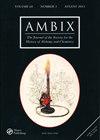土星的统治转变为黄金时代
IF 0.3
3区 哲学
Q3 HISTORY & PHILOSOPHY OF SCIENCE
引用次数: 0
摘要
亚伦·切克的鲁贝多出版社出版了著名的炼金术专著《Saturnia Regna》的新拉丁-英语版本。继《赫尔墨斯的娱乐》(2017)、《巴西莲格言》(2018)和《赫尔墨斯密室的钥匙》(2020)之后,这是该出版社出版的第四本双语炼金术教科书。《土星的统治》由四部分组成:冗长的引言(第9-81页)、1657年《土星》的拉丁-英语正面版(第82-222页)、编辑的注释和评论(第223-280页)和参考书目(第281-300页)。《Saturnia Regna》本身包括原书的序言(Praefatio)(第85-94页)、“赫尔墨斯命题”(第95-176页)和“吕底亚石”(Lapislydius,第177-200页),它们构成了书的主要部分,以及原书的最后一部分,标题为“实践”(Praxis)。1657年,《Saturnia Regna》在巴黎首次以拉丁文出版,书名为《Saturnia Regna in aurea saecula conversa》,英文书名为《土星的统治转变为黄金时代》。在首字母S. M. T. F. P旁边,没有作者的名字;扉页只提到了一位来自巴黎的“哲学家”,Huginus Barma,他出资出版了这本书。这本书早在1674年就被翻译成德语,后来又被翻译成法语(1780年)和意大利语(1986年)。这本书是第一次用英文出版。这本书是值得注意的,因为在两个主要部分,“赫尔墨斯命题”和“吕底亚石”,文本仍然非常哲学和神秘,没有指导实际的(所有)化学工作。相比之下,在书的末尾简短的实践提供了详细的实践说明,在化学和化学语言训练的化学家可以执行。假设这些是不同作者的文本是合理的。在他们细致的研究中,编辑们在奥地利国家图书馆发现了一份1649年的Saturnia Regna手稿,比1657年在巴黎印刷的文本早了8年。在这本手稿的扉页上,作者的名字缩写为p.f.t.m.s.,书名是Saturnia Regna sive Magisterium Sapientum,即《土星的统治》,或《智者的权威》。标题页上的首字母与印刷书的顺序相反,没有提到Huginus Barma。如果他只支付了巴黎印刷费,这也就不足为奇了。但另一个名字出现在扉页上,那就是“摩拉维亚的圣弗朗西斯·德·保拉”。编辑们无法确认这个人的身份,但当时在今天的捷克共和国布尔诺附近的弗拉诺夫的摩拉维亚margravate有一个波林修道院。因此,有理由认为手稿起源于摩拉维亚。但与印刷文本的主要区别在于,手稿中没有包含《Praefatio》或《practice》,而是包含了另外三篇炼金术文本。编辑们正确地将“实践法”放在了迈克尔·森迪沃吉(Michael Sendivogius, 1566-1636)的炼金术配方中,这些配方描述了从地下提取的盐制备哲人石的方法,他们还提供了一个图表,显示了这些过程的一个子组的各个步骤(第279页),这些步骤被描述为“operazione filosofica”。引言包括对Sendivogius的想法和这种类型的食谱的谱系的信息概述,列出了大约十个版本。其中最著名的是约翰·约阿希姆·贝歇尔(1635-1682)在1682年出版的炼金术配方集Chymischer glks - hafen(第231-240页)中出版的两个版本。编辑们认为胡吉努斯的《实践》是这种食谱最早的印刷版本,但这一荣誉被取消了本文章由计算机程序翻译,如有差异,请以英文原文为准。
The Reign of Saturn Transformed into an Age of Gold
Aaron Cheak’s Rubedo Press has published a new Latin-English edition of the well-known alchemical treatise Saturnia Regna. After Hermetic Recreations (2017), The Basilian Aphorisms (2018), and The Key to the Hermetic Sanctum (2020), this is the fourth dual-language edition of alchemical texts by this publisher. The Reign of Saturn consists of four parts: the lengthy introduction (pp. 9–81), the LatinEnglish facing-page edition of the 1657 Saturnia Regna (pp. 82–222), the editors’ annotations and commentary (pp. 223–280), and a bibliography (pp. 281–300). The Saturnia Regna itself comprises the preface (Praefatio) of the original book (pp. 85–94), the “Hermetic Propositions” (Positiones Hermeticae, pp. 95–176) and the “Lydian Stone” (Lapislydius, pp. 177–200) which form the main parts of the book, and the final part of the original book, titled “practice” (Praxis). Saturnia Regna was first published in Latin in Paris 1657 as Saturnia Regna in aurea saecula conversa, which gives the English title The Reign of Saturn Transformed into an Age of Gold. Beside the initials S. M. T. F. P., no author is named; the title page only mentions a certain “philochymist” from Paris, Huginus à Barma, at whose expense the book was printed. The text was translated into German as early as 1674, and later also into French (1780) and Italian (1986). It is here available in English for the first time. The book is remarkable because in the two main parts, the “Hermetic Propositions” and the “Lydian Stone,” the text remains extremely philosophical and mystical, with no guidance for practical (al)chemical work. In contrast, the short Praxis at the end of the book provides detailed practical instructions that a chemist trained in chymistry and chymical language could implement. It is reasonable to assume that these are texts by different authors. During their meticulous research, the editors found a manuscript of Saturnia Regna in the Austrian National Library dated 1649, eight years before the text appeared in print in Paris in 1657. On the title page of this manuscript, the author is abbreviated with the initials P. F. T. M. S., and the title is given as Saturnia Regna sive Magisterium Sapientum, i.e. The Reign of Saturn, or the Magisterium of the Wise. The initials on the title page are in reverse order compared to the printed book and Huginus à Barma is not mentioned. This is no surprise if he paid for printing of the text in Paris only. But another name appears on the title page, that of “Patre Gabriele Gotifredo ordinis St. Francisi de Paula in Moravia.” The editors could not identify this person, but at that time there was a Pauline monastery in the Margraviate of Moravia in Vranov near Brno in modern-day Czech Republic. So it is reasonably assumed that the manuscript originated fromMoravia. But the main difference to the printed text is that the manuscript does not contain the Praefatio or the Praxis, but instead three other pieces of alchemical text. The editors correctly place the Praxis in a large group of alchemical recipes developed in the tradition of Michael Sendivogius (1566–1636) that describe the preparation of the Philosophers’ Stone from salts extracted from the earth, and they provide a diagram showing the individual steps for a subgroup of these processes (p. 279), which have been characterised as “operazione filosofica.” The introduction includes an informative overview of Sendivogius’ ideas and a lineage of this type of recipe, listing about ten versions. The best known of these are the two versions published by Johann Joachim Becher (1635–1682) in his alchemical recipe collection Chymischer Glücks-Hafen of 1682 (pp. 231–240). The editors assume that Huginus’s Praxis is the earliest printed version of such a recipe, but this honour goes
求助全文
通过发布文献求助,成功后即可免费获取论文全文。
去求助
来源期刊

Ambix
HISTORY & PHILOSOPHY OF SCIENCE-
CiteScore
0.80
自引率
60.00%
发文量
42
审稿时长
3 months
期刊介绍:
Ambix is an internationally recognised, peer-reviewed quarterly journal devoted to publishing high-quality, original research and book reviews in the intellectual, social and cultural history of alchemy and chemistry. It publishes studies, discussions, and primary sources relevant to the historical experience of all areas related to alchemy and chemistry covering all periods (ancient to modern) and geographical regions. Ambix publishes individual papers, focused thematic sections and larger special issues (either single or double and usually guest-edited). Topics covered by Ambix include, but are not limited to, interactions between alchemy and chemistry and other disciplines; chemical medicine and pharmacy; molecular sciences; practices allied to material, instrumental, institutional and visual cultures; environmental chemistry; the chemical industry; the appearance of alchemy and chemistry within popular culture; biographical and historiographical studies; and the study of issues related to gender, race, and colonial experience within the context of chemistry.
 求助内容:
求助内容: 应助结果提醒方式:
应助结果提醒方式:


